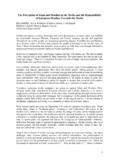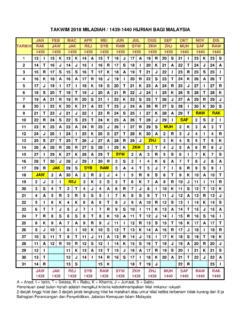Transcription of Arabia before Islam - Richard N. Frye
1 Arabia before Islam Richard N. Frye Just as trade had been the dominant feature of Arabia in an earlier period so now religion became the leitmotif of the era under discussion. Not that trade lost its importance, but after the fall of the Roman Empire the demand for luxury goods from the east subsided. Also there was not the great quantity of gold available to pay for the imports, and India still sought gold in payment for spices. It was not until the sixth century when the Byzantine and Sasanian Empires had become stabilized that new demands for eastern luxuries became so important that trade in silk, spices and perfumes had a great influence on the politics of the time. But common people were more concerned with religion. The written sources which have survived are almost exclusively religious, in contrast to the earlier period where secular documents are available.
2 From the third century of our era religion usurped all other activities in the concerns of people. This is reflected not only in writings but in art and architecture and indeed in every aspect of life. The period from the fourth to the eighth century could be called the age of religions. Another difference between the earlier and later periods of the history of Arabia is that earlier the cultural influence, as well as the migrations of tribes, went from south to north, for south Arabian civilization was more advanced than the north. But from the fourth to the eighth century of our era the reverse obtains; south Arabian tribes underwent the influence of north Arabia . All of the old south Arabian scripts vanished and the north Arabic script used by the Lakhmids, and possibly of Nabataean origin, was spread to the south.
3 Some scholars have characterized the later period as the 'Dark Ages' of Arabia in contrast to the earlier period, although this designation may have been influenced by the common view of the contemporary history of western Europe. The fourth century of our era saw the spread of universal religions and their forging of orthodoxies, and this development obviously had repercussions in Arabia although they occurred later. The religious consolidation paralleled the establishment of the centralized Sasanian Empire with its Zoroastrian church organization and the Byzantine empire with Christianity as the state religion. During this period, to the rise of Islam , several kingdoms in Arabia rose, declined and fell. Some were powerful and enjoyed independence while others were vassals of one or the other great empire.
4 A third force was Ethiopia which became a Christian state, and in alliance with Byzantium, extended its influence in south Arabia . In the south the Himyarites not only established a new kingdom about 300 but they embarked on a policy of expansion and soon ruled all of south Arabia , while to the north they extended as far as Najran, south of Mecca. During the later fourth century and afterwards the Himyarites introduced monotheism into their religion which had been a polytheism. Mention of one god, Rahmanan 'the Merciful' was initiated by the Himyarites. At the end of the fifth century Abu Kariba, also called Ma'd Karib Ya'fur, the Himyarite king with his center in Yemen accepted Judaism as his faith. His son and successor Yusuf Dhu Nuwas began a persecution of Christians in his realm, especially against those in Najran in 518, which provoked a reaction of Najashi ruler of the Ethiopians in Axum.
5 He sent a large army to Yemen in 517 which defeated Dhu Nuwas who fled. Almost all of south Arabia then was ruled by the Ethiopians who set up a viceroy Abraha over the land. Dhu Nuwas sought the aid of the Sasanians and an embassy was sent to al-Hira, capital of the Lakhmid vassals of the Sasanians, for help, but none came. Dhu Nuwas returned and regained power. He tried to exterminate pro-Axumite people but in 524 a tripartite military alliance of the Byzantine Empire, the Axumite Ethiopian kingdom and south Arabian Christians was formed against Dhu Nuwas. He was defeated and either killed or committed suicide, which ended the line of Himyarite kings. Abraha now consolidated his rule and gained control of the spice trade, which was the main objective of Ethiopian interest in south Arabia .
6 Abraha built a church in San'a, and in order to attract pilgrims to his center he sent missionaries to different regions of Arabia . At that time Mecca was a place of pagan pilgrimage and Abraha sought to divert pilgrims to San'a to his Christian shrine. It seems that pilgrims would go to a shrine, pagan or Christian, simply because it was a consecrated or holy place. When someone from the north defiled his church Abraha marched against Mecca with elephants in his army. That year was recorded as the year of the elephant, and it is mentioned in the Quran, but Abraha was unsuccessful and turned back. South Arabia was dependant on Axum, but a vassal king was set up, and a unique dual government was instituted, with the king's administration side by side with the Ethiopian military settlements which were independent of local authorities and probably of the king himself.
7 The first king was Sumafa Ashwa and he remained faithful to Ethiopian rule. His grandson Sayf, however, wanted to free himself from Ethiopian tutelage. At first he turned to the Byzantines for help but they declined since they were co-religionists with the Axumites. Sayf then approached the Persians and the Sasanian king Khusro I sent some ships to aid Sayf who had fled Ethiopian rule. The Persians sent a force to Yemen under a Persian general Wahriz who succeeded in conquering south Arabia in 577 and reinstalling Sayf as king. The Ethiopians reacted by supporting a counter-king but he was deposed by the Persians in 599. Thus south Arabia became virtually a province of the Sasanian Empire, and it replaced Ethiopia as the dominant force in the south which entered the politics of the two great powers to the north.
8 The Christian and Jewish competition in south Arabia was now joined by a third religion, Zoroastrianism although the latter was not as missionary-oriented as the other two. Not only in south Arabia but also in the north Christianity made converts while Medina or Yathrib had a substantial Jewish population and only in Bahrain in eastern Arabia did Zoroastrianism have adherents. Even though both the Byzantines and the Sasanians sought to obtain a monopoly of trade, in western Arabia independent merchants were able to prosper in the period before the rise of Islam . In the fifth century for the first time in recorded history we learn of an Arab kingdom in central Arabia established by the Kinda tribe. Under the reign of al-Harith b. 'Amr in the last decades of the fifth century all of the tribes in Najd, central Arabia , were united into a kingdom of Kinda.
9 His son in 510 attacked border lands of the Byzantine Empire and the emperor Anastasius was obliged to conclude peace with the Kindites. Al-Harith also attacked the Sasanians but in 529 he was killed by the Lakhmid vassals of the Persians. After his death the kingdom was divided among his sons and was finally dissolved. We know about Kinda mainly because a later Kindite prince Imru'l-Qays was a famous pre- Islamic Arab poet some of whose verses have survived. It should be mentioned that the most important source for information about Arabia just before Islam is pre-Islamic Arabic poetry. Much was recorded in Islamic times and from it we see the overwhelming importance of tribal society. The poetry is mainly concerned with tribal warfare, with lonely camel trips on the desert, or the longing for one's beloved.
10 As mentioned even the settled folk in oases were divided by tribal allegiances such that this time could be called the tribal period of Arabia 's history. Eastern Arabia , however, had been under strong Iranian influences from early times, but now direct rule was instituted. Eastern Arabia , on the shores of the Persian Gulf, came under Persian rule in the time of the Sasanian ruler Shapur II (310-379) who led expeditions far into Arabia and defeated marauding tribes. After a period of independence in the sixth century the region again fell to the Sasanians who appointed a Lakhmid king as their governor. Persian garrisons and settlers were established in Bahrain, Oman and elsewhere in the east. Traces of underground irrigation canals called qanats found in Oman were probably the result of Iranian techniques brought there by settlers from Iran.







